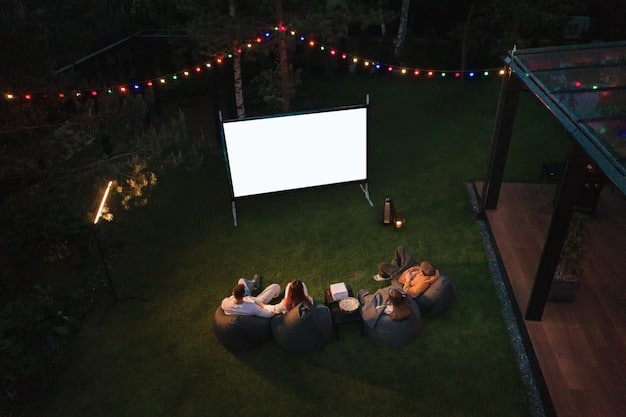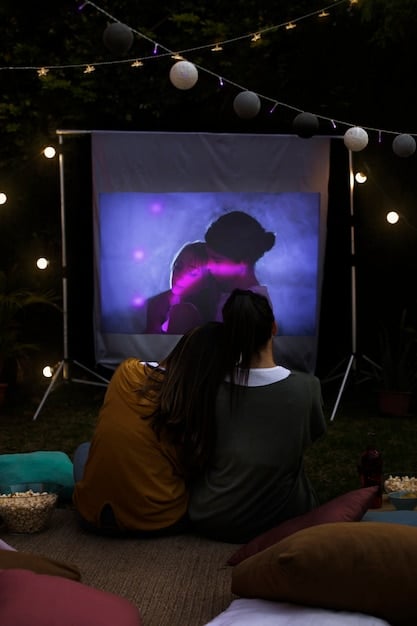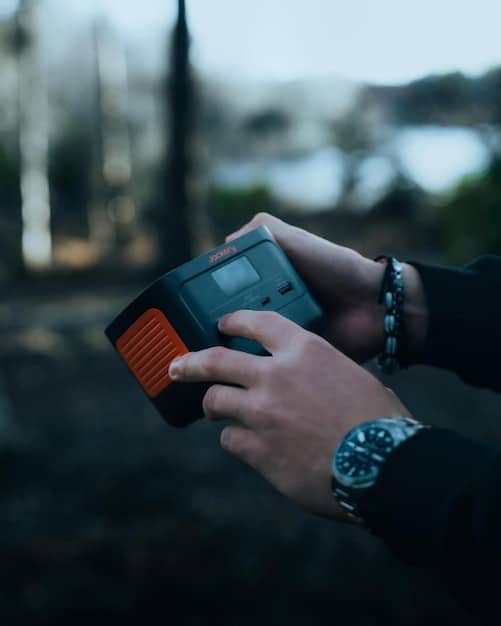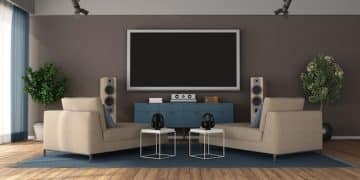Portable Projectors: Your Guide to Outdoor Movie Nights

Portable projectors offer a fantastic way to bring the cinema experience outdoors, transforming your backyard or any open space into a personal movie theater under the stars, but choosing the right one involves considering brightness, resolution, portability, and connectivity.
Planning an outdoor movie night? A portable projector can turn any space into a cinema under the stars. Here’s how to choose the perfect one!
Why Choose a Portable Projector for Outdoor Movie Nights?
Portable projectors are revolutionizing how we enjoy movies, especially during warm summer nights. Their compact size and ease of setup make them an ideal choice for creating unforgettable experiences in your backyard, at a campsite, or even on a rooftop.
But what makes them so appealing?
Convenience and Flexibility
Unlike traditional home theater systems, portable projectors don’t require permanent installation. You can set them up in minutes and move them around as needed. This flexibility means you’re not limited to one location for your movie nights.
Cost-Effective Entertainment
Investing in a portable projector can save you money in the long run. Instead of frequent trips to the movie theater, you can enjoy movies, sports events, or video games from the comfort of your own space. It’s a one-time investment that provides endless entertainment.

Here are some additional benefits to consider:
- Easy Setup: Most portable projectors are user-friendly, with simple interfaces and quick setup processes.
- Versatile Use: Beyond movies, use them for presentations, gaming, or displaying photos.
- Family-Friendly: Create a fun and engaging environment for kids and adults alike.
Choosing a portable projector opens up a world of possibilities for entertainment. It’s about bringing people together and creating memories in unique and exciting ways. This section has highlighted some of the key reasons why portable projectors are an excellent choice for outdoor movie nights, focusing on their convenience, cost-effectiveness, and versatility.
Understanding Key Features to Look For
When shopping for a portable projector, several key features will determine the quality of your viewing experience. Understanding these features will help you make an informed decision and choose a projector that meets your specific needs.
Here’s what to consider:
Brightness (Lumens)
Brightness is crucial, especially for outdoor use where ambient light can be a factor. Look for projectors with higher lumens, generally 2000 lumens or more, to ensure a clear and vibrant image even in partially lit conditions.
Resolution
Resolution determines the sharpness and detail of the projected image. While HD (720p) can be sufficient, Full HD (1080p) or even 4K resolution projectors will provide a more immersive and detailed viewing experience. Consider the screen size you plan to use, as larger screens benefit from higher resolutions.
Other essential features include:
- Contrast Ratio: A higher contrast ratio means better black levels and more detail in dark scenes.
- Lamp Life: Consider the projector’s lamp life, as replacing the lamp can be costly. LED projectors generally have longer lamp lives than traditional lamp projectors.
- Connectivity: Ensure the projector has the necessary ports (HDMI, USB, etc.) to connect your devices, such as laptops, streaming sticks, or gaming consoles.
Understanding these key features – brightness, resolution, contrast ratio, lamp life, and connectivity – is essential for selecting the right portable projector for your outdoor movie nights. By considering these aspects, you can ensure a high-quality viewing experience that meets your specific needs and preferences. This knowledge empowers you to make an informed purchase and enjoy countless memorable movie nights under the stars.
Portability Factors: Size, Weight, and Battery Life
True to their name, portability is a defining characteristic of portable projectors. However, not all portable projectors are created equal when it comes to their physical attributes and power capabilities. It’s essential to consider these factors carefully to ensure the projector suits your intended use scenarios.
Let’s delve deeper into the key portability aspects:
Size and Weight
A truly portable projector should be compact and lightweight, making it easy to carry around. Look for models that can fit in a backpack or even a large pocket. Lighter projectors are also easier to mount on a tripod or other support.
Battery Life
If you plan to use your projector in locations without access to a power outlet, battery life is a critical consideration. Some portable projectors have built-in batteries that can last for several hours on a single charge, allowing you to enjoy a full-length movie without worrying about running out of power.

Consider these additional points:
- Carrying Case: Check if the projector comes with a carrying case for easy transport and protection.
- Power Options: Some projectors can be powered via USB, making them even more versatile for on-the-go use.
- Fan Noise: While not directly related to portability, quieter projectors enhance the viewing experience, especially in quiet outdoor settings.
When evaluating portable projectors, consider the size, weight, and battery life to ensure it aligns with your specific needs. If you plan to use it frequently in different locations, prioritizing a compact and lightweight model with good battery life is essential. This ensures you can easily transport and set up your projector wherever your movie nights take you. Keep fan noise in mind as well, as quieter projectors will improve the overall viewing experience.
Connectivity and Compatibility: What to Connect?
A versatile portable projector should seamlessly integrate with your existing devices and content sources. This makes connectivity and compatibility crucial factors when making your selection. Understanding the available ports and wireless capabilities will ensure a smooth and enjoyable viewing experience.
Here’s a breakdown of what to look for:
HDMI Ports
HDMI (High-Definition Multimedia Interface) is the most common port for connecting devices like laptops, Blu-ray players, gaming consoles, and streaming sticks. Ensure the projector has at least one HDMI port, preferably two, to accommodate multiple devices.
USB Ports
USB ports allow you to connect USB drives, external hard drives, and even charge some devices. Some projectors can play media files directly from a USB drive, eliminating the need for a separate playback device.
Further connectivity considerations:
- Wireless Connectivity: Many portable projectors offer built-in Wi-Fi and Bluetooth, enabling wireless streaming from smartphones, tablets, and other devices.
- Screen Mirroring: Some projectors support screen mirroring technologies like Miracast or AirPlay, allowing you to wirelessly project content from your mobile devices.
- Audio Output: Check for audio output options like a 3.5mm headphone jack or Bluetooth audio support, allowing you to connect external speakers or headphones for enhanced sound.
When evaluating portable projectors, carefully consider the available connectivity options and compatibility with your devices. HDMI and USB ports are essential for connecting various media sources, while wireless connectivity offers added convenience for streaming and screen mirroring. Also, consider the audio output options to ensure you can easily connect external speakers or headphones. By prioritizing these connectivity features, you can create a truly versatile and enjoyable outdoor movie night experience.
Setting Up Your Outdoor Movie Night: Tips and Tricks
Once you’ve selected your portable projector, it’s time to set up your outdoor movie night. Proper setup will enhance the viewing experience and ensure a memorable evening for everyone involved. Here are some tips and tricks to help you create the perfect outdoor cinema:
Let’s get started!
Choosing the Right Location
Select a location that is dark, flat, and free from obstructions. A backyard, patio, or even a campsite can work well. Avoid areas with excessive ambient light, such as streetlights or neighbor’s windows.
Screen Options
While you can project onto a blank wall or sheet, using a dedicated projector screen will provide the best image quality. Inflatable screens are a popular choice for outdoor use, as they are easy to set up and take down.
Don’t forget these additional tips:
- Sound System: The built-in speakers on portable projectors are often adequate, but consider using external speakers for a more immersive sound experience. Bluetooth speakers can be a convenient option.
- Seating: Provide comfortable seating for your guests. Lawn chairs, blankets, or even inflatable couches can create a relaxed and enjoyable atmosphere.
- Snacks and Drinks: No movie night is complete without refreshments. Prepare some snacks, drinks, and popcorn to keep your guests happy and satisfied.
Setting up an outdoor movie night is a fun and rewarding experience. By carefully selecting the location, screen, sound system, seating, and refreshments, you can create a memorable evening for your guests. Experiment with different setups and adjust based on your specific needs and preferences to create the perfect outdoor cinema experience. Remember the key is to provide a dark, comfortable, and inviting environment where everyone can relax and enjoy the movie.
Maintaining and Storing Your Portable Projector
To ensure your portable projector lasts for many outdoor movie nights to come, proper maintenance and storage are essential. Following these guidelines will help prolong the life of your projector and keep it performing at its best.
Here’s how to care for your projector:
Cleaning the Lens
The lens is the most critical part of the projector, and keeping it clean is essential for maintaining image quality. Use a soft, lint-free cloth to gently wipe the lens. Avoid using harsh chemicals or abrasive cleaners.
Proper Storage
When not in use, store your projector in a cool, dry place. Avoid exposing it to extreme temperatures or humidity. Using a carrying case can help protect the projector from dust, scratches, and other damage.
Consider these additional points:
- Dust Removal: Regularly clean the projector’s air filters to prevent dust buildup, which can cause overheating and reduce performance.
- Lamp Care: If your projector uses a traditional lamp, follow the manufacturer’s recommendations for lamp replacement. Avoid frequent on-off cycles, as this can shorten the lamp’s lifespan.
- Software Updates: Check for software updates from the manufacturer and install them to ensure your projector is running the latest firmware.
Proper maintenance and storage are essential for keeping your portable projector in top condition. Regularly cleaning the lens, removing dust, and storing the projector in a safe environment will help prolong its lifespan and maintain picture quality. Following the manufacturer’s recommendations for lamp care and software updates will further enhance performance and prevent potential issues. By taking these simple steps, you can enjoy countless outdoor movie nights with your portable projector for years to come.
| Key Point | Brief Description |
|---|---|
| 💡 Brightness | Higher lumens (2000+) ensure clear viewing in ambient light. |
| 📏 Resolution | Full HD (1080p) or 4K offers sharper, more detailed images. |
| 🔋 Battery Life | Essential for locations without power outlets, lasting several hours. |
| 🔌 Connectivity | HDMI, USB, Wi-Fi, and Bluetooth for versatile device connections. |
Frequently Asked Questions
▼
The ideal screen size depends on the projector’s brightness and resolution, as well as the viewing distance. Generally, a screen size of 80-120 inches works well for most portable projectors.
▼
Connect external speakers or headphones via the projector’s audio output. Bluetooth speakers are a convenient wireless option. Adjusting the projector’s built-in audio settings can also help.
▼
Portable projectors are best suited for dark or low-light environments. During the day, the projected image may be washed out by ambient light. Use a projector with high lumens and a dark screen.
▼
Inflatable screens are a popular choice due to their ease of setup and large size. Other options include fixed-frame screens or even a simple white sheet stretched tightly.
▼
Avoid using the projector in wet or humid conditions. Keep it covered when not in use and store it in a dry place. Consider using a waterproof carrying case for added protection.
Conclusion
Choosing the right portable projector for outdoor movie nights involves considering factors like brightness, resolution, portability, connectivity, and setup. With the right projector and setup, you can transform any outdoor space into a personal cinema, creating unforgettable experiences for family and friends.





